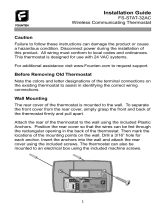
18
Step 4 — Check Thermostat Operation
The Legacy Series thermostats have a built--in installer test capability. Use it to
check thermostat and equipment operation without delays or setpoint adjustments
to force heating or cooling.
To enter the Installer Test mode, use the same process as is used to enter Installer
Configuration, only hold the FAN key longer. More specifically, press and hold the
FAN for about 15 seconds until the d isplay reads In on the left and St on the right
for the programmable model, or InS in the smaller d isplay for the
non--programmable model. The MODE will be OFF. The MODE key (upper left)
can now be used to select heat, cool, or emergency heat, if this is a HP thermostat.
Selecting one of the available modes will immediately command the equipment to
turn on in that mode. It will run for 3 minutes and then return the mode to off. With
HP thermostats (having 2 stages of heating), the test will run for 3 minutes on each
stage. If the thermostat is programmable, the clock display counts down from 180
seconds while each stage operates. Changing the mode to OFF will terminate any
running test immediately.
During any test, the display icons will be displayed the same as for normal
operation of that stage, as follows:
SELECTED MODE
DISPLAY ICONS
off off
cool cool on
heat heat on, aux heat on
Em Heat aux heat on
To termina te the In staller Test m ode press the DONE or FAN b utton. If the
thermostat is left in Installer Test mode, it will revert back to normal operation after
15 minutes.





















